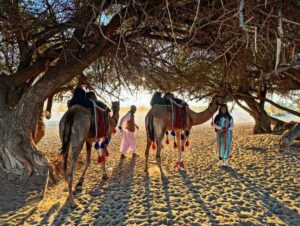Ultrarunner Peter Van Geit has just spent the entire summer fast-hiking in the Indian Himalaya. His 3,000km project covered a staggering 120 passes and 125,000m of elevation gain, at a pace three to four times quicker than the average hiker.

All photos: Peter Van Geit
Born in Belgium but living in India for the last 20 years, Van Geit describes himself as an “intersection of an explorer, ultrarunner and alpinist.” He ran back in college but only picked it up again two decades later, in 2013. In the interim, he had hiked long, hard routes in South India. This Trans Himalayan run is not his first marathon of this kind. In 2018, he ran 2,000km through the mountains of Vietnam, then did a further 1,500km in the Himachal Pradesh.

The red-bearded Belgian ran almost entirely solo and crested about one high pass a day. He wasn’t sure of his actual pace, but he soldiered on for 10 to 12 hours every day. In less challenging terrain, he could cover 40 to 45km, but mostly he averaged 25 to 30km as he journeyed through Ladakh and the North Indian states of Uttarakhand and Himachal.

Van Geit’s route, all 120 passes of it.
To keep up such a torrid pace, he went minimalist with his gear. His small pack weighed just five kilos. His equipment blended that of the high-altitude hiker with the bare-bones alpinist. He didn’t carry a tent, just a half-kilo bivy sack. Despite the frequent snow, he opted for trail running shoes rather than heavy hiking boots.
His sleeping bag weighed just 600g, yet it allowed him to sleep in sub-zero temperatures. “Some of my campsites were on top of glaciers at nearly 5,000m altitude,” he said.
He was burning 6,000 to 8,000 calories a day, but still had to minimize weight, so instead of cooking fuel, he carried a small amount (100ml) of kerosene to soak bits of dry horse or cow dung, over which he cooked. He carried just enough food to make it between villages, five to six days in the most remote regions.

Van Geit and his five kilos of gear.
The idea of a Trans-Himalayan run came to him a few years ago, when he saw some tourist maps showing several 4,000 to 5,000m passes across the high ranges. He preferred trail and off-trail travel to running on roads. When he tried to research the route, he discovered that the Indian Himalaya are not well documented. “There are hundreds of these passes, some used only by shepherds and local people,” he said. “[Eventually] I managed to put together a list of over 100 passes across a pretty long section of the Himalaya. Then I said, okay, let me see how fast I can cross them.”

Beginning in May, he crossed Uttarakhand from the border of eastern Nepal to Himachal via 30 sub-4,000m passes, which kept him below the snow line during that early time of year. He next traversed Himachal, then went over several passes of the Great Himalayan National Park, Dhauladar and the Pir Panjal. Many of these 45 high-altitude passes were more difficult than he expected because of the unprecedented amount of snowfall that winter.

After three months, Van Geit had explored 83 passes, covered 2,100km and reached a maximum altitude of 6,200m. He had hiked and run across glaciers, moraines, scree, deep snow, dangerous streams and steep ice slopes. Luckily, by the end of July, most of the snow had melted below 5,000m, making it slightly easier for him.
Unlike the rest of his trip, many routes and passes through Ladakh were marked on Open Street Maps and the Swiss Olyzane hiking map series. He completed his 120 passes in the lesser-known interior mountains between Zanskar and Lahaul, and in some of the interior valleys of Hemis.
The most difficult and dangerous parts of the route were the stream crossings, especially in Ladakh. Most of the water is glacial meltwater, and in peak summer, the melting glaciers create swift and frigid torrents. In particular, landslides had taken out the trails along the Orna River, forcing ticklish crossings at the limits of Van Geit’s ability.

This year, there was also a high risk of crevasses, hidden even in summer by the unusually heavy snow. Finally, on some of the scrambles on loose rocks, he ran the risk of slipping and falling several hundred metres down the steep drops into the valley below.

Dressed minimally and carrying few warm clothes made wind and rain above 4,000m particularly daunting. “You have to keep moving to keep yourself warm,” he said. “One benefits of being much quicker than the average hiker was that I could mostly sleep at a lower altitude. I tried to camp below 3,000m as often as possible.”

Of his 120 nights on the trail, he overnighted on about 40 of them with people he met. Being temporarily adopted by local families was understandably one of the highlights of the adventure.

Van Geit has now been home for a little over a month. The former competitive runner admits that he is moving further away from organized races in favour of other long-distance adventures. He next plans to climb 200 Shivaji forts, many of which are perched on mountaintops like guard towers, across India’s Western Ghats. he expects to take two months.
You can find more details about his Trans-Himalayan route on his website.







